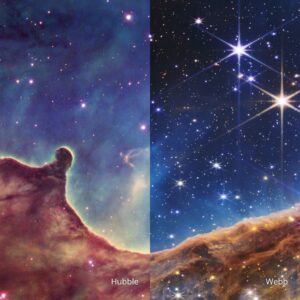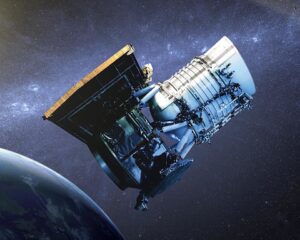Space telescopes have played a pivotal role in advancing our understanding of the universe. By observing celestial objects beyond the Earth’s atmosphere, these instruments provide us with a unique perspective and invaluable data. From the humble beginnings of ground-based telescopes to the groundbreaking Hubble Space Telescope (HST), let’s explore the future of space telescopes and the exciting advancements that lie ahead.
Evolution of Space Telescopes
A. Ground-based Telescopes
Ground-based telescopes, primarily optical telescopes, have long been our window to the cosmos. However, atmospheric distortions and light pollution limit their capabilities. Nevertheless, continuous advancements in adaptive optics and large-aperture designs have improved their resolution and sensitivity.
B. Hubble Space Telescope (HST)
The launch of the Hubble Space Telescope in 1990 revolutionized astronomy. Orbiting above the Earth’s atmosphere, HST provided unprecedented clarity and sharpness in its observations. It revealed breathtaking images of distant galaxies, discovered exoplanets, and deepened our understanding of cosmic phenomena. The success of HST paved the way for the development of future space telescopes.
Advanced Technologies Shaping the Future
 A. James Webb Space Telescope (JWST)
A. James Webb Space Telescope (JWST)
The launch of the James Webb Space Telescope (JWST) represents the next frontier in space telescope technology. Equipped with advanced infrared instruments, JWST will peer deeper into the universe, enabling us to study the formation of galaxies, the birth of stars, and the potential for life on exoplanets. Its massive segmented mirror and innovative cooling system will allow it to operate at incredibly low temperatures, maximizing its sensitivity and observing capabilities.
 B. WFIRST (Wide Field Infrared Survey Telescope)
B. WFIRST (Wide Field Infrared Survey Telescope)
WFIRST, the Wide Field Infrared Survey Telescope, promises to provide a panoramic view of the cosmos. With its wide field of view, it will survey the sky in infrared wavelengths, allowing us to study dark energy and explore the mysteries of the expanding universe. WFIRST will also detect and characterize thousands of exoplanets, providing crucial insights into their atmospheres and potential habitability.
C. Next-generation X-ray Telescopes
X-ray telescopes, such as the Chandra X-ray Observatory, have been instrumental in studying high-energy phenomena like black holes and supernovae. The upcoming Athena mission aims to take X-ray astronomy to new heights. With its advanced mirror technology and high-resolution spectrometers, Athena will provide unprecedented sensitivity and imaging capabilities, unraveling the mysteries of the X-ray universe.
D. High-resolution Ultraviolet Telescopes
Ultraviolet (UV) telescopes, such as LUVOIR (Large UV Optical Infrared Surveyor) and HabEx (Habitable Exoplanet Observatory), are poised to explore the UV region of the electromagnetic spectrum. These telescopes will offer high-resolution imaging, allowing us to study exoplanets, investigate the early universe, and gain insights into the formation of galaxies. Their observations will provide valuable data for understanding the conditions necessary for life.
Innovative Telescope Concepts
A. Space-based Gravitational Wave Detectors
In addition to traditional telescopes, space-based gravitational wave detectors like LISA (Laser Interferometer Space Antenna) and Pulsar Timing Arrays offer a new way to explore the universe. By detecting gravitational waves, these instruments provide a unique perspective on celestial events such as merging black holes and neutron stars. They complement traditional telescopes by observing phenomena that emit no light, opening a new window to the cosmos.
B. Extremely Large Telescopes (ELTs)
Extremely Large Telescopes (ELTs) represent the future of ground-based astronomy. With their giant segmented mirrors, ELTs like the Thirty Meter Telescope (TMT) and the European Extremely Large Telescope (E-ELT) will revolutionize our ability to observe and understand the universe. These telescopes will have significantly larger apertures, allowing them to collect more light and achieve higher resolution. ELTs will enable astronomers to study the atmospheres of exoplanets in more detail, explore the formation of galaxies, and delve into the mysteries of dark matter and dark energy.
C. CubeSat and SmallSat Telescopes
The miniaturization of technology has led to the development of CubeSat and SmallSat telescopes, opening up new opportunities in space-based astronomy. These compact satellites, often no larger than a shoebox, can be deployed in constellations or formations to work collaboratively. CubeSat and SmallSat telescopes are cost-effective, allowing for more frequent launches and enabling a broader range of scientific missions. They can contribute to various fields of study, such as monitoring space weather, tracking asteroids, and even conducting targeted observations of specific celestial objects.
Advancements in Data Analysis and Processing
As space telescopes continue to gather vast amounts of data, advancements in data analysis and processing techniques are essential to extracting meaningful insights. Machine learning and artificial intelligence play crucial roles in handling and analyzing these massive datasets. These tools can assist in pattern recognition, identifying astronomical objects, and making sense of complex phenomena. By combining the power of advanced telescopes with sophisticated data analysis, astronomers can uncover hidden patterns and discoveries within the vast cosmic data.
Collaborative International Efforts
 The future of space telescopes relies heavily on international collaborations. Space agencies and astronomers from around the world come together to share resources, expertise, and knowledge. Collaborative projects foster innovation and enable ambitious missions that no single nation could undertake alone. By pooling resources, space agencies can tackle the significant challenges of building and launching complex space telescopes, ultimately advancing our collective understanding of the universe.
The future of space telescopes relies heavily on international collaborations. Space agencies and astronomers from around the world come together to share resources, expertise, and knowledge. Collaborative projects foster innovation and enable ambitious missions that no single nation could undertake alone. By pooling resources, space agencies can tackle the significant challenges of building and launching complex space telescopes, ultimately advancing our collective understanding of the universe.
Future Discoveries and Exploration
As we look to the future, the potential for groundbreaking discoveries and new frontiers of exploration with space telescopes is exhilarating. From understanding the nature of dark matter and dark energy to searching for signs of extraterrestrial life, these advanced telescopes will propel us forward in our quest to unravel the mysteries of the universe. Each new generation of space telescopes brings us closer to answering age-old questions and igniting new ones, expanding the boundaries of human knowledge.
Conclusion
The future of space telescopes holds immense promise for advancing our understanding of the cosmos. From the recently launched James Webb Space Telescope and WFIRST to innovative concepts like space-based gravitational wave detectors and CubeSat telescopes, these technologies will revolutionize astronomy. Through international collaborations and advancements in data analysis, we are poised to make remarkable discoveries and explore uncharted territories. The universe beckons, and with the continued development of space telescopes, we are on the cusp of unlocking its most profound secrets.








No Comment! Be the first one.